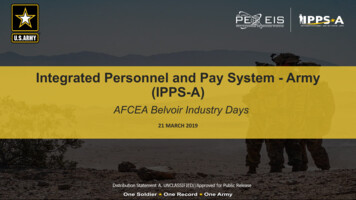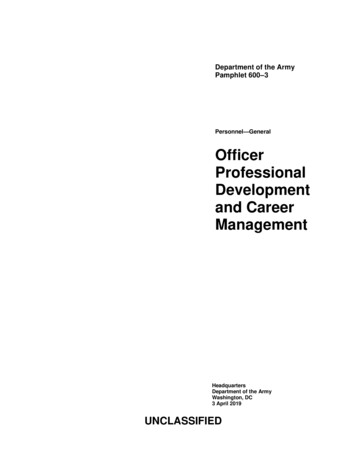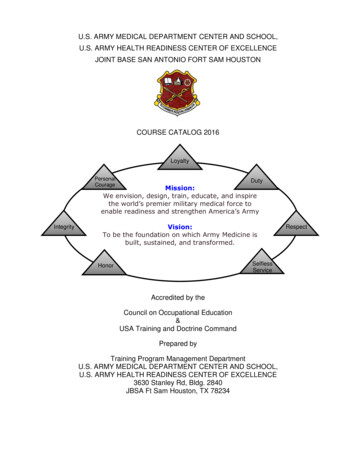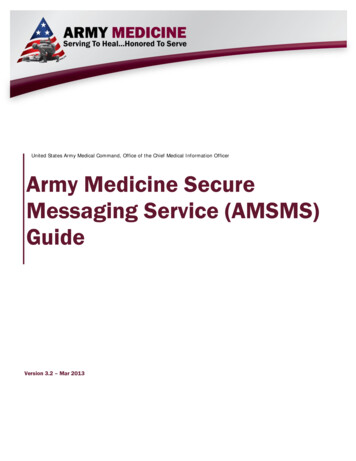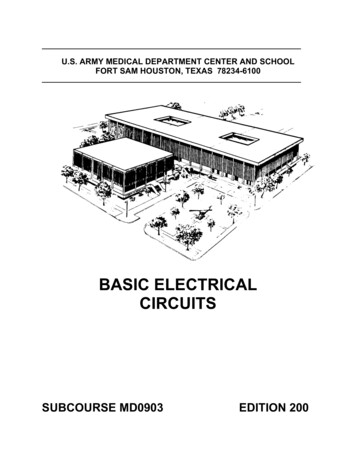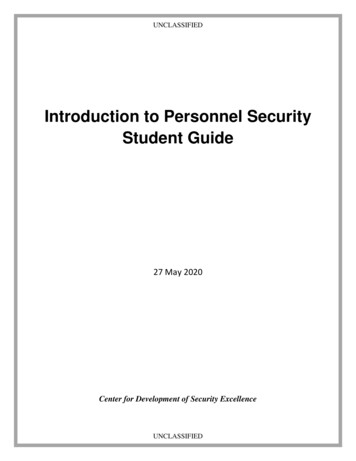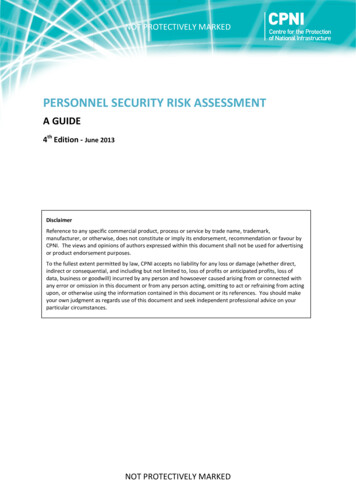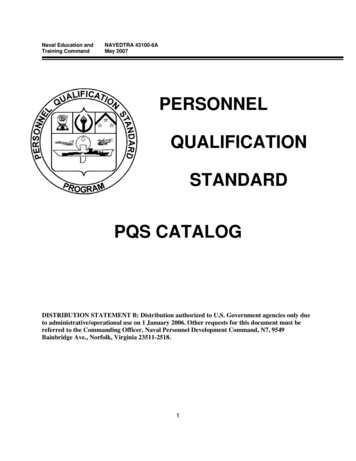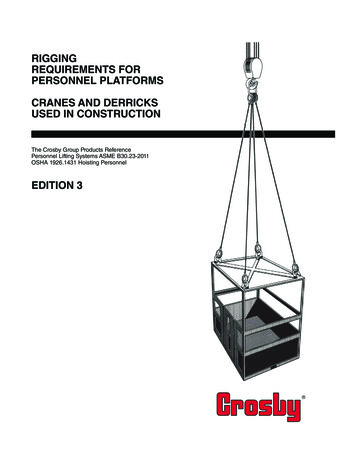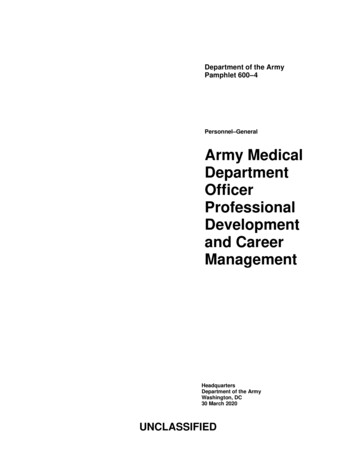
Transcription
Department of the ArmyPamphlet 600–4Personnel–GeneralArmy MedicalDepartmentOfficerProfessionalDevelopmentand CareerManagementHeadquartersDepartment of the ArmyWashington, DC30 March 2020UNCLASSIFIED
SUMMARY of CHANGEDA PAM 600–4Army Medical Department Officer Professional Development and Career ManagementThis expedited revision, dated 30 March 2020—oRemoves reference to Multi-Source Assessment and Feedback tool (para 2–2c).oChanges the name of the Army Medical Department Center & School to the U.S. Army Medical Center ofExcellence (para 3–2).oProvides clarification on what constitutes a credentialing course for Army Medical Department officers (para 4–2c).oClarifies time in service and eligibility requirements for attendance to Senior Service College in accordance withAR 350–1 (para 4–2d).oAdds the references that cover the Ready Reserve (para 6–2a).oAdds the references that manage Army National Guard officers and warrant officers (para 6–3a).
HeadquartersDepartment of the ArmyWashington, DC30 March 2020*Department of the ArmyPamphlet 600–4Personnel–GeneralArmy Medical Department Officer Professional Development and CareerManagementthe rank of colonel or the civilian equivalent. Activities may request a waiver tothis pamphlet by providing justificationthat includes a full analysis of the expected benefits and must include a formalreview by the activity’s senior legal officer. All waiver requests will be endorsedby the commander or senior leader of therequesting activity and forwarded throughtheir higher headquarters to the policyproponent. Refer to AR 25–30 for specificApplicability. This pamphlet applies toguidance.the Regular Army, the Army NationalGuard/Army National Guard of the Suggested improvements. UsersUnited States, and the U.S. Army Re- are invited to send comments and sugserve, unless otherwise stated. During gested improvements on DA Form 2028mobilization, procedures in this publica- (Recommended Changes to Publicationstion can be modified to support policy and Blank Forms) directly to The Surgeonchanges as necessary.General (DASG–HR), 7700 ArlingtonBlvd, Falls Church, VA 22042–5140.Proponent and exception authority.The proponent of this pamphlet is The Distribution. This pamphlet is availaSurgeon General. The proponent has the ble in electronic media only and is inauthority to approve exceptions or waiv- tended the Regular Army, the Army Naers to this pamphlet that are consistent tional Guard/Army National Guard of thewith controlling law and regulations. The United States, and the U.S. Army Reproponent may delegate this approval au- serve.thority, in writing, to a division chiefwithin the proponent agency or its directreporting unit or field operating agency, inon leader development concepts and responsibilities, information on opportunities for Army Medical Department command positions, offers detailed information on development and managementof Reserve Component Army MedicalDepartment officers, and outlines Armypromotion policy including special considerations for Army Medical Departmentofficers.History. This publication is an expedited revision.Summary. This pamphlet outlines officer professional development and careermanagement programs for each of theArmy Medical Department's six corps.Although it does not prescribe a path ofassignments and educational opportunities that will guarantee success, it does describe the full spectrum of developmentalopportunities and programs that officerscan expect throughout their careers. In addition, this pamphlet provides guidanceContents (Listed by paragraph and page number)Chapter 1Introduction, page 1Purpose 1–1, page 1References and forms 1–2, page 1Explanation of abbreviations and terms 1–3, page 1Overview 1–4, page 1Background 1–5, page 1Warrior ethos and Army Values 1–6, page 1The Army profession 1–7, page 2Mentoring, counseling, and coaching 1–8, page 2Army Medical Department officer career management overview 1–9, page 2Army Medical Department warrant officer career management overview 1–10, page 3Chapter 2Army Medical Department Officer Leader Development, page 4Leader development strategy 2–1, page 4*This publication supersedes DA Pam 600–4, dated 6 September 2018.DA PAM 600–4 30 March 2020UNCLASSIFIEDi
Contents—ContinuedDomains of leader development 2–2, page 4Leader principles 2–3, page 5The Army Medical Department corps 2–4, page 5Areas of concentration and medical functional areas 2–5, page 6Chapter 3Army Medical Department Officer Career Management, page 6Overview 3–1, page 6Aspects of career management 3–2, page 6Individual career management 3–3, page 8Chapter 4Army Medical Department Officer Education and Training, page 8Scope 4–1, page 8Military education 4–2, page 9Civilian education 4–3, page 10Interagency Institute for Federal Healthcare Executives Course 4–4, page 11Military Health System Capstone Symposium 4–5, page 12Warrant Officer Education System 4–6, page 12Chapter 5Officer Promotions, page 14General 5–1, page 14Promotion process objectives 5–2, page 14Statutory requisites 5–3, page 14Active duty list 5–4, page 15Promotion process 5–5, page 15Army grade structure 5–6, page 16Promotion flow 5–7, page 16Definition of promotion zones 5–8, page 17Competitive categories 5–9, page 17Impact of Officer Personnel Management System evolution 5–10, page 17Selective continuation 5–11, page 18Officer promotions in the Reserve Component 5–12, page 18Chapter 6Reserve Component Army Medical Department Officer Career Management, page 19Introduction 6–1, page 19Reserve Components 6–2, page 19Professional development 6–3, page 20Leader development 6–4, page 22Reserve Component promotions 6–5, page 23Company and field grade officer career management 6–6, page 25Warrant officer career management 6–7, page 27Career management life cycle 6–8, page 29Career management considerations 6–9, page 31Individual mobilization augmentee and/or drilling individual mobilization augmentee assignments (Army Reserve) 6–10, page 32Company and field grade officer education opportunities 6–11, page 32AppendixesA. References, page 35Table ListTable 5–1: The promotion system, page 15DA PAM 600–4 30 March 2020ii
Contents—ContinuedTable 6–1: Reserve Officer Personnel Management Act time-in-grade requirements, page 23Table 6–2: Nonresident military schools, page 33GlossaryDA PAM 600–4 30 March 2020iii
Chapter 1Introduction1 –1. PurposeThis pamphlet provides guidance to commanders, assignment officers (AOs), mentors, and individual officers concerning leader development to include the duties, responsibilities, and roles of commissioned and warrant officers(WOs) of the Army Medical Department (AMEDD) in support of the U.S. Army and Department of Defense (DOD).It should also be used as a general guide to plan assignments, education, and training for optimum military service byeach AMEDD officer. This pamphlet will be used in conjunction with the Smartbook DA Pam 600–4 (see app A),which provides more details on command and career management for each of the AMEDD corps.1 –2. References and formsSee appendix A.1 –3. Explanation of abbreviations and termsSee the glossary.1 –4. OverviewSimilar concepts for Human Resources Command (HRC) managed branches, operating under the Officer PersonnelManagement System (OPMS), are outlined in DA Pam 600–3. This pamphlet will be used in conjunction with DAPam 600–3 to provide a basic frame of reference for AOs at all levels and the individual AMEDD officer. Officersare encouraged to read both DA Pam 600–3 and Smartbook DA Pam 600–3, regardless of branch, functional area,military occupational specialty (MOS), or career field held, because unique and valuable lessons in Army culture andofficer professional development are found in every section.1 –5. Backgrounda. The AMEDD is unique in terms of commissioned officer human resource management, because it and the otherspecial branches are not formally integrated into OPMS, which provides the framework for HRC officer career management programs and policies. The AMEDD officer, like their basic branch-managed counterparts, is highly skilledand trained in his or her specialty. However, the primary difference stems from the specialized nature of modern healthcare, which requires developing single, highly specialized skills rather than the multiple skills identified in the "dualtrack" concepts of OPMS. As the Army has sought to inculcate a sense of professionalism throughout the Total Force,per Army Doctrine Publication (ADP) 1, the AMEDD constitutes a diverse group of “dual professionals” who balanceidentification as a health care professional and as a member of the profession of arms. As an organization, the AMEDDmust value the contributions and career development of health care providers as clinical subject-matter experts whileensuring core Army operational proficiency. The AMEDD must also vigilantly monitor health care professionals, asnatural tensions sometimes exist between the profession of arms and medicine.b. The mission of the AMEDD is to provide health services for the Army and, as directed, for other agencies,organizations, and the other Services. Since the Medical Department was established, in 1775, six officer corps orbranches have been developed to provide the leadership and professional expertise necessary to accomplish the broadSoldier support functions implicit to the mission. Success in accomplishing the AMEDD mission lies in teamworkamong all health professionals while providing optimum health care to Soldiers, their Families, and other beneficiaries.c. The key to the distinctive human resource management system of the AMEDD is the corps. The AMEDD iscomposed of six corps. The separate nature of the many disciplines within the six corps, comprising the total healthcare delivery system, dictates some diversity in approach to managing the personnel within that system. Althoughseparate and unique, the six corps cannot effectively function apart from one another, due to the commonality createdby the mission.1 –6. Warrior ethos and Army ValuesEverything begins with the warrior ethos. The warrior ethos compels Soldiers to fight through all conditions to victoryno matter how much effort is required. It is the Soldiers’ selfless commitment to the nation, mission, unit, and to theirfellow Soldiers. It is the professional attitude that inspires every American Soldier. Warrior ethos is grounded inrefusal to accept failure. It is developed and sustained through discipline, commitment to Army Values, and pride inthe Army’s heritage. Warrior ethos is the foundation for our total commitment to victory in peace and war. It is theDA PAM 600–4 30 March 20201
conviction that military service is much more than just another job. It defines who officers are and what they do. It islinked to this country’s longstanding Army Values and the determination to do what is right and do it with pride.Soldiers enter the Army with their own values, developed in childhood and nurtured through experience. We are allshaped by what we have seen, what we have learned, and whom we have met. However, once Soldiers put on theuniform and take the oath, they have opted to accept a warrior ethos and have promised to live by the Army Values.Army Values form the very identity of the Army. They are non-negotiable and apply to everyone at all times in allsituations. The trust that Soldiers have for one another and the trust the American people put in Soldiers demands thatSoldiers live up to these values. These values are interdependent; that is, they support one another. You cannot followone value and ignore another. The seven values that guide all leaders and the rest of the Army are loyalty, duty, respect,selfless service, honor, integrity, and personal courage. Leaders must believe in these values, model them in theirpersonal actions, and teach others to accept them. AMEDD officers require a demonstrated mastery of the MilitaryHealth System (MHS), their branch, functional area, or area of concentration (AOC) specific skills, and grounding inthese seven Army Values to successfully lead Soldiers in the 21st century.1–7. The Army professiona. The Army profession defined. The Army is an American profession of arms, a vocation composed of expertscertified in the ethical application of land combat power, serving under civilian authority, entrusted to defend theConstitution and the rights and interests of the American people.b. The Army professional defined. An American professional Soldier is an expert, a volunteer certified in the profession of arms, bonded with comrades in a shared identity and culture of sacrifice and service to the Nation and theConstitution, who adheres to the highest ethical standards and is a steward of the future of the Army Profession.1 –8. Mentoring, counseling, and coachinga. Today’s leaders have the critical responsibility to develop future leaders who are prepared to meet tomorrow’schallenges. An essential component of this development is mentoring. The term mentorship refers to the voluntary,developmental relationship between a person of greater experience and a person of lesser experience that is characterized by mutual trust and respect. ADP 6–22 provides additional information on mentorship.b. Mentorship impacts both personal development (maturity, interpersonal, and communication skills) as well asprofessional development (technical and tactical knowledge, and career-path knowledge).c. The goal of mentorship is to help the lesser-experienced person reach their personal and professional potential.It is critical to understand that mentorship is not any one behavior or set of behaviors, but rather includes all of theleader development behaviors (for example, counseling, teaching, coaching, and role modeling) that are displayed bya trusted advisor.d. The strength of the mentorship relationship is based on mutual trust and respect. Assessment, feedback, andguidance accelerate the developmental process and enhance performance. When this occurs within a mentoring relationship, even higher performance results.e. Mentoring requires taking advantage of any opportunity to teach, counsel, or coach to build skills and confidencein the mentored. Mentoring is not limited to formal, structured sessions, but can include every event from quarterlytraining briefs, to after action reviews, to unstructured, casual, recreational activities. To aid in the mentorship (andcareer management) process, the Army has developed and implemented the Army Career Tracker (available athttps://actnow.army.mil), an Army leadership development tool that uses the professional development model andprovides a common picture of training and experience. Used properly, this tool facilitates structured mentorship andcan be used and revised by successive mentors as an officer progresses in experience. Additionally, the Army Mentorship Program (available at http://myarmybenefits.us.army.mil) is an official effort to provide additional resourcesfor leaders and junior officers.f. One of the most important legacies that today’s senior leaders can leave with the Army is to mentor junior leaders.Mentoring develops great leaders to lead great Soldiers.1 –9. Army Medical Department officer career management overviewa. Purpose. The purpose of AMEDD officer career management is to enhance the effectiveness and professionalism of the AMEDD officer corps. This encompasses all policies and procedures by which Army company grade, fieldgrade, and warrant officers are trained, educated, developed, assigned, evaluated, promoted, and separated from activeduty. Officer career management in the AMEDD consists of career management policies and procedures that assurea deployable, professional officer corps capable of meeting the challenges of the future.b. Objectives of Army Medical Department officer career management.DA PAM 600–4 30 March 20202
(1) Provide quality officers in sufficient numbers, and with the appropriate grades and skills, to meet the healthmanpower requirements of the Army, taking maximum advantage of the education, abilities, and interests of the individual officer.(2) Ensure continuation of education and training that provides the opportunity to grow as both a military officerand a health professional.(3) Assign officers where they can maximize their talents and training in the health care delivery system and meetindividual desires and preferences.(4) Facilitate a high degree of motivation, professional opportunity, and career satisfaction among the six AMEDDcorps.c. Responsibility for career management. The Surgeon General (TSG) is responsible for AMEDD officer careermanagement within the policies established by the Deputy Chief of Staff (DCS), G–1. This responsibility is directedthrough the Director of Human Resources, Office of the Surgeon General (OTSG), and executed through the Commander, HRC, who manages Active and Army Reserve AMEDD Active Guard Reserve (AGR), Individual ReadyReserve (IRR) and Individual Mobilization Augmentation (IMA) officers with the advice and assistance of theAMEDD corps chiefs and professional consultants. Career management and development of Active Component (AC)and Reserve Component (RC) AMEDD officers is the primary function of each AMEDD branch, Health ServicesDivision (HSD), HRC (see chap 3). It is here that the fundamental personal contact between the officer and his or her"branch" occurs. Army National Guard (ARNG) AMEDD officers are managed by the Military Personnel Office(MILPO) of the ARNG organization in each State. ARNG AMEDD officers on Title 10, United States Code 10 (0USC) AGR orders are managed by National Guard Bureau (NGB) Human Capital Management in conjunction withtheir State MILPO. Each ARNG Joint Force Headquarters (JFHQ) has a MILPO with an officer management branchpossessing the authority to make AOC changes within regulatory guidance and direction from the ARNG Chief Surgeon's Office. AMEDD officers in the U.S. Army Reserve (USAR) not on extended active duty are managed by careermanagement officers (CMOs) at HRC. AGR officers in the USAR are managed by the Reserve Branch at HSD, HRC.ARNG AGR officers are managed by support career management officers according to National Guard Regulation(NGR) 600–5 (see chap 6).d. Army Medical Department assignment officers. Career management is effective when the qualitative manpowerrequirements of the Army, the training and skills of the individual, and the desires and career development of theofficer concerned are balanced. Knowledge of requirements is usually the known or given part of the career management equation. The individual officer's needs, on the other hand, are more difficult to determine. Human resourcesmanagers and AMEDD officers must effectively communicate with each other to ensure the continued successfulprogression of career assignment, education, and utilization.(1) Active Component officers. In the absence of dialogue with the HRC Branch or lack of written communication,the AOs may not be aware of personal goals, interests, and individual situations of the officer managed. Regular Army(RA) officers should communicate their career goals and interests to their rater, other appropriate personnel in theirchain of command, their AOC consultant, and their AO in the AMEDD Branch, HSD, HRC.(2) Reserve Component officers not on extended active duty assigned to units. Human resources management andcareer service support is provided by the unit's Reserve and full-time unit support. Officers should communicate theircareer goals and interests to their raters and other appropriate leaders in the chain of command. The JFHQ MILPOand Personnel Program manager at the ARNG Chief Surgeon’s Office are also available to provide career guidanceand general information about assignment opportunities.(3) Reserve Component officers
The AMEDD officer, like their basic branch-managed counterparts, is highly skilled and trained in his or her specialty. However, the primary difference stems from the specialized nature of modern health care, which requires developing single, highly specializ
